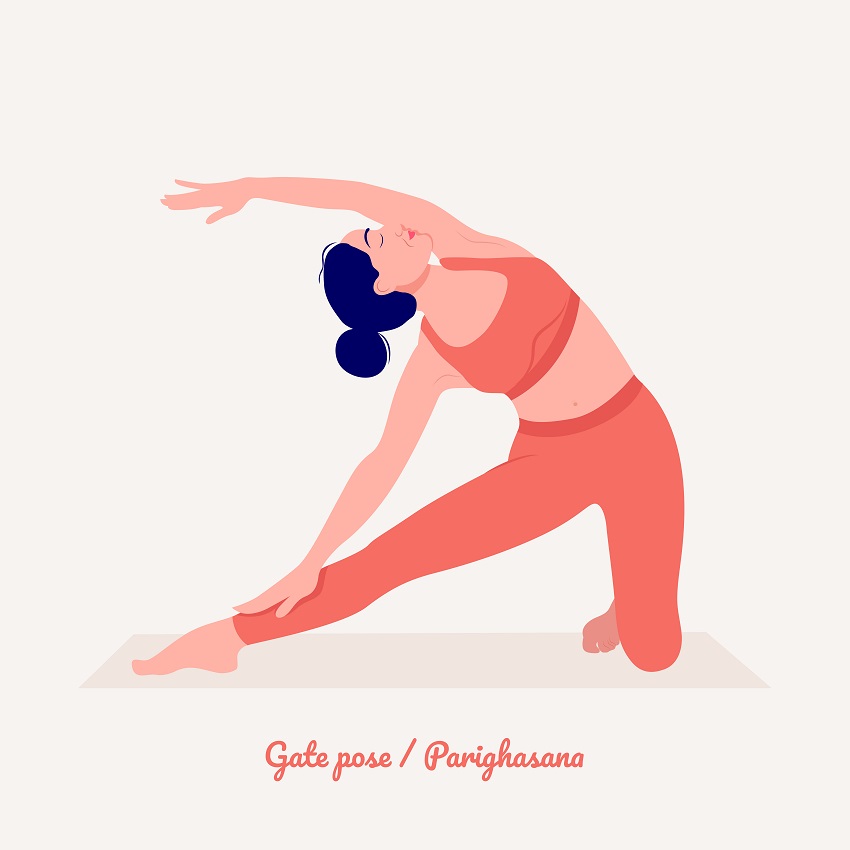Gate Pose: (Parighasana)
Name: Gate Pose
Sanskrit: Parighasana
Pronunciation: par-ee-GAHS-ah-nah
Pose Level: Gate pose is a beginner-level yoga asana

Anatomy Involved:
Gate pose is a posture that improves body posture and is helpful to strengthen your side body. It includes stretching intercostal muscles, spine muscles, and back muscles. Parighasana is recommended for those who need to strengthen their ankles and feet. Practicing gate pose may help to reduce pain in the lumbar regions. Its potential to ease stiffness in muscles, makes it senior citizen friendly, as well.
Related Article: Breathing Exercises for Seniors : Helpful For Calming Nerves?
Benefits:
- Helps to stretch the pelvic region.
- May help improve bladder and bowel conditions.
- Improve the functioning of abdominal organs.
- Improve flexibility of muscles in the back.
- Stretches the hamstrings
- Opens shoulder muscles
- Improves breathing mechanism, circulation of blood, and digestion.
Step-by-Step Instructions:
- Firstly, kneel on your yoga mat with your palms facing downward.
- Place your hands palm down on the mat as well;
- Then swing your left toes toward the left side of the mat. The right foot will automatically follow;
- As the right leg follows, extend it to the bottom of the mat, and place pressure on the outward portion of the foot;
- Afterwards, come on to the left fingertips and up with the right hand;
- Then, take the right hand and give the right thigh a “slap” to awaken this muscle group;
- Slowly grab your left rib cage with the right hand to open the chest. The left hand should be pressing down into the mat or a block;
- Then, take the right hand and move it gracefully up the side of the body and overhead, giving way to a nice long stretch;
- Breathe and lengthen the tailbone. This is the final pose.
Related Article: What is the Meaning of Pranayama: Pranayama Breathing Techniques
Pose Modifications:
For example, could the yogi use a supportive pillow or blanket? Is there another variation of the maneuver?
Those with joint problems or severe knee pain can modify gate yoga according to the situation.
In case of knee pain, you can use a chair edge for sitting with a bent knee, extend your one leg.
If it is difficult to place your knee directly on the surface, you can also use a blanket under your bent knee.
You can also press your foot against a wall if extending your leg on the yoga mat is hard to maintain.
In addition, you may place the “down” hand on a yoga block to give yourself more height. Experiment with your gaze and work your neck gently.
Contraindications:
If you have the following conditions, you may want to avoid gate pose or ask a medical expert or certified yoga instructor for guidenace:
- Less than three months old knee injury.
- Chronic inflammation in the knee.
- Severe pain in the shoulder, ankle joints, or back pain.
Poses Commonly Transitioned too:
Parighasana can be used to prepare for Utthita Trikonasana, Parivrtta Janu Sisrsana, and Utthita Parsvakonasana.
Poses Commonly Transitioned From:
Adho Mukha Svanasana, Baddha Konasana, Prasarita Padottanasana, Supta Padangusthasana, Upavistha Konasana, Utthita Parsvakonasana, and Utthita Trikonasana are different preparatory poses that help to execute Parighasana.




